I recently had the opportunity to try out Gem Blenders, a new TCG by… uh, Gem Blenders.
After a brief demo at PlayNYC 2024 (now a subsection of AnimeNYC, which is an article in itself), I picked up two starter decks so I could try playing a full game. It's tough being a collectible card game these days, competing with the likes of Magic: The Gathering, Lorcana, and more, but this was a newcomer that was able to get off the ground using Kickstarter, so I wanted to check it out to see how it stacked up.
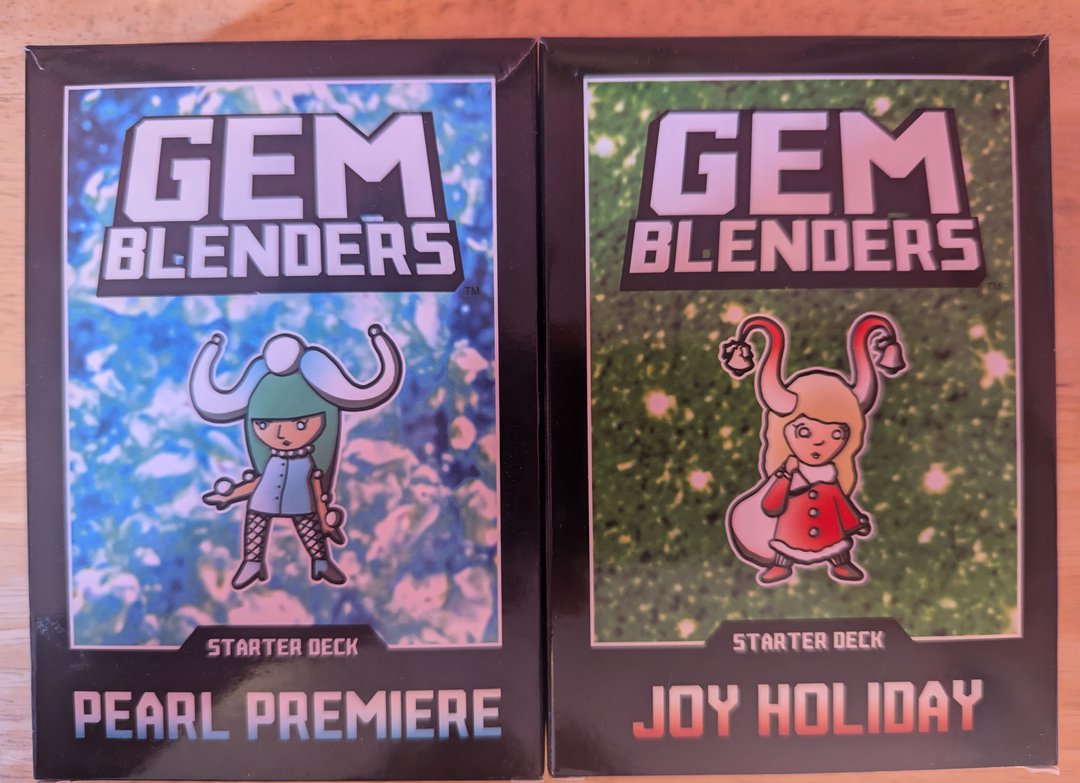
My decks, two of the four starters that are currently available.
Pearl Premiere is a straightforward beatdown deck, while Joy Holiday relies on card manipulation to make sure you always have what you need.
Making Your Perfect Blend
Since this is a TCG, deckbuilding is naturally a big part of the game. So, what goes into a Gem Blenders deck?
Each deck starts with four heroes, no two of which can be the same. These are typeless characters with low stats, typically 0 ATK and 0 DEF, but strong abilities to help you outpace your opponent in the early game. You then need 50 more cards, which can be almost any combination you want of actions, gems, and blends. We’ll get to those other card types in a minute.
I say almost any combination because there are a few caveats here. You can’t run more than 3 copies of any non-hero card (except for basic gems, which have no limit). You’re also limited to five action stars, which are symbols that show up on especially nasty action cards. I really like the action star mechanic for a couple of reasons: first, because it makes you carefully choose what to spend your 5 stars on, and second, because it means the game won't be automatically dominated by the rich kid who can just buy all the best action cards.
...I may have a bit of unresolved trauma from my Yu-Gi-Oh days.
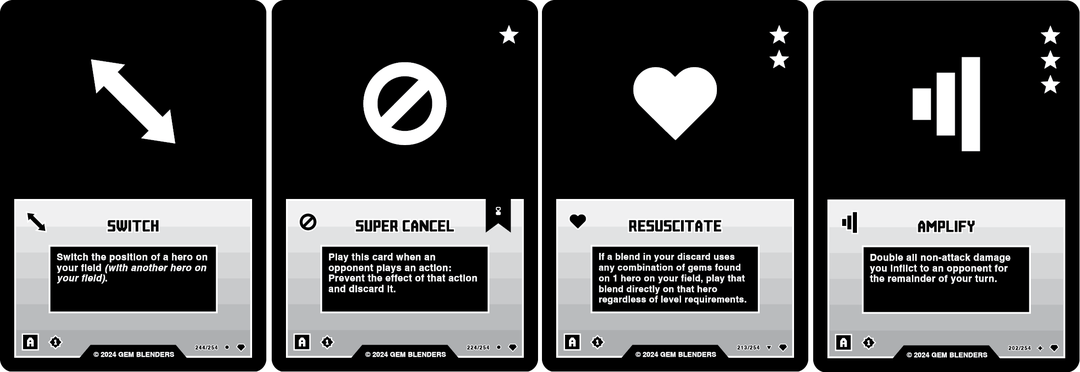
The right action at the right time could change the whole course of the game, so choose wisely.
Aside from those restrictions you’re free to put together whatever deck suits your playstyle best, or most reminds you of your favorite Gem from Steven Universe. It's honestly a really good take on deckbuilding that learns from several of the old school giants that are out there.
Your (Gem) Blender User Manual
Let's start with the inevitable comparison to better-known games: Gem Blenders plays most similarly to Pokemon TCG, though with enough of its own ideas that it certainly isn’t just a copycat.
Each game starts with the players setting out their four Heroes in a diamond formation. Positioning is important because each character can only attack the character directly across from them, and the one in back can’t attack (or be attacked) at all. But remember that I said most Heroes have 0 ATK and 0 DEF—that obviously makes them pretty useless in combat, but this is where gems and blends come in.
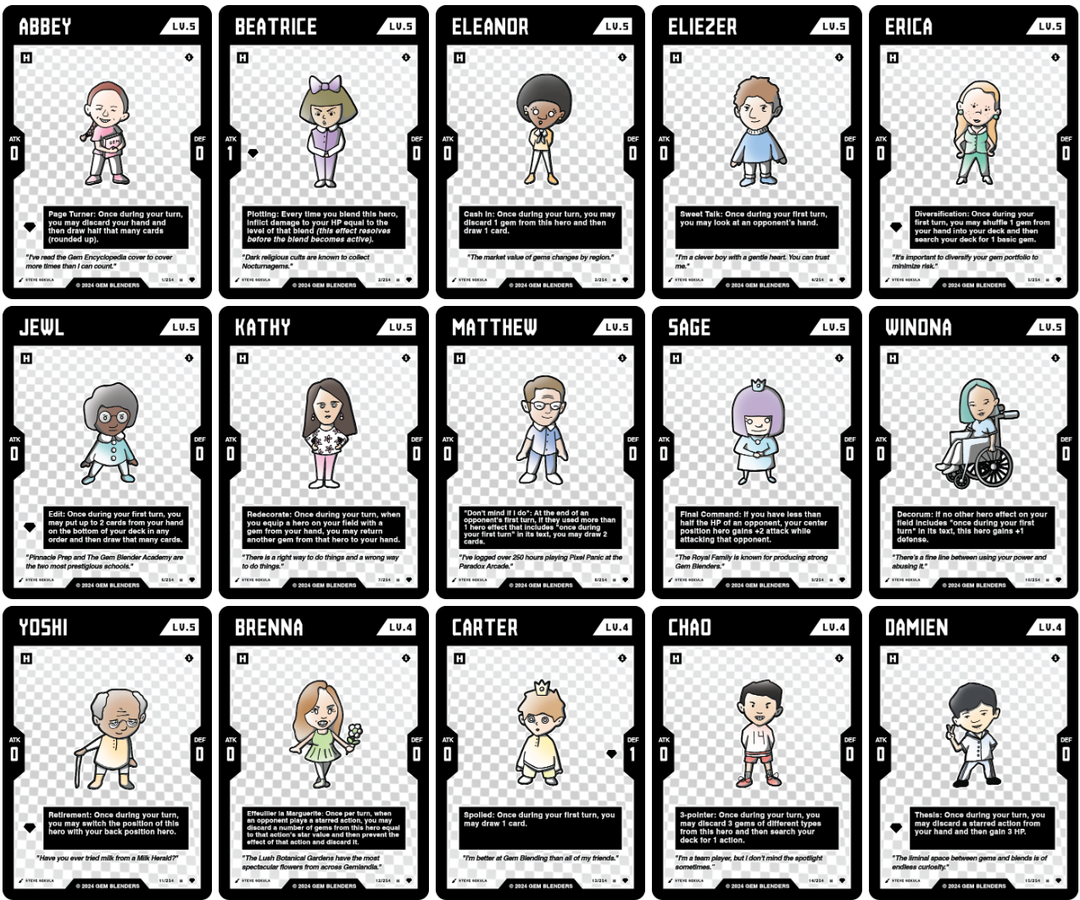
A few of the many heroes you can choose as the foundation for your deck.
Each turn you can play one Gem from your hand by equipping it to one of your characters. The Gems have no effects of their own, although some abilities require the character to have Gems before you can use them. But, more to the point, equipping the right Gems lets you play Blends, which are more powerful characters that actually make combat possible. Once you have a character with an ATK above 0, you can use it to attack your opponent. If your ATK is higher than the defender’s DEF, you deal the difference to the player's HP.
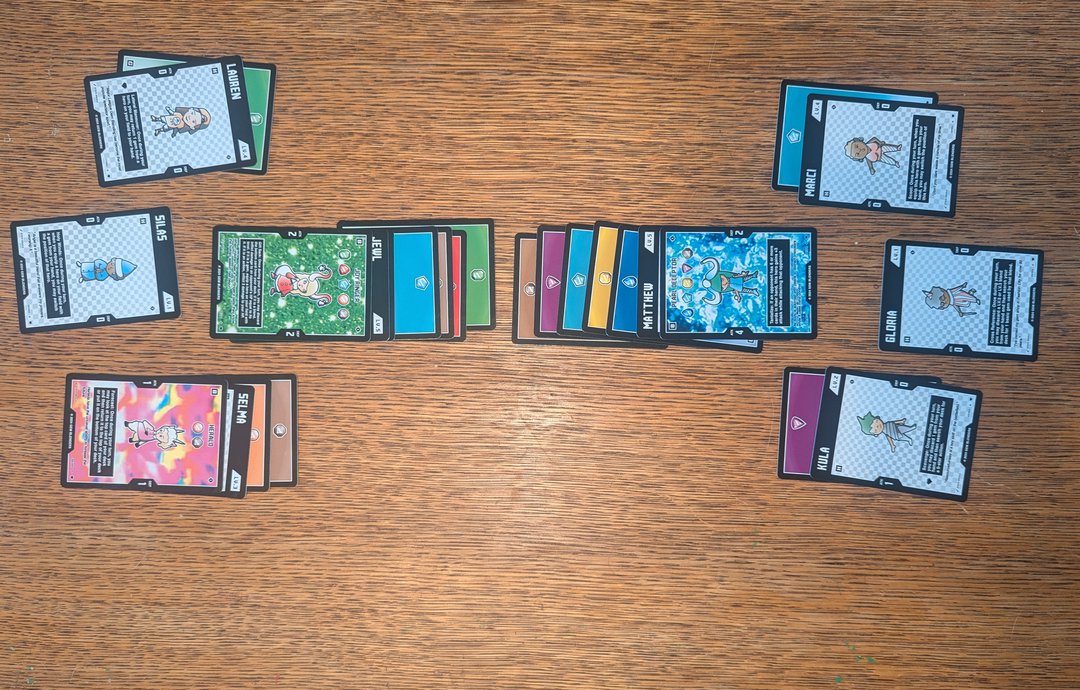
So: play your starting characters, equip the right cards to make them work, “evolve” them, and then battle… you see where the Pokemon comparison comes in.
When a player's HP drops from 20 to 0 they're out — and, as you’d probably expect, the last player standing wins. However, there's an interesting twist here that I haven't seen in other TCGs: A full match of Gem Blenders is best of three games, but you don't reset your field or hand in between games. Each player is allowed to swap in one hero from their "bench," then all HP resets to 20 and you just keep playing. This rule is a bit of a mixed bag because, if you've ever been that player who just needed one more turn for their deck to fire off, now you have it! On the other hand, if one player is really dominating the field, there's no reset to give the other(s) another chance.
...On the other-other hand, a really dominant player would most likely win the next game whether there's a reset or not. My final answer is that I'll need to play some more before I decide if this is an overall good rule or not.
Finally, the action cards are pretty straightforward, but they make it much easier to do all of the other things I just talked about. action cards have no cost, you can play as many as you want on your turn, and they… well, they do whatever is written on the card. Think Sorcery cards in Magic, or Trainer cards in Pokemon. There are also some actions that go off during your opponent’s turn, but they’re rare enough that they don't have their own card type.
Initial Reactions
The starter decks were a little underwhelming to play, but they were simple enough for newbies to get a handle on the rules (which is the point, after all). They also came with one booster pack each, so I got a little taste of what else Gem Blenders has to offer. Some of these look pretty powerful… if you can manage to get them working.
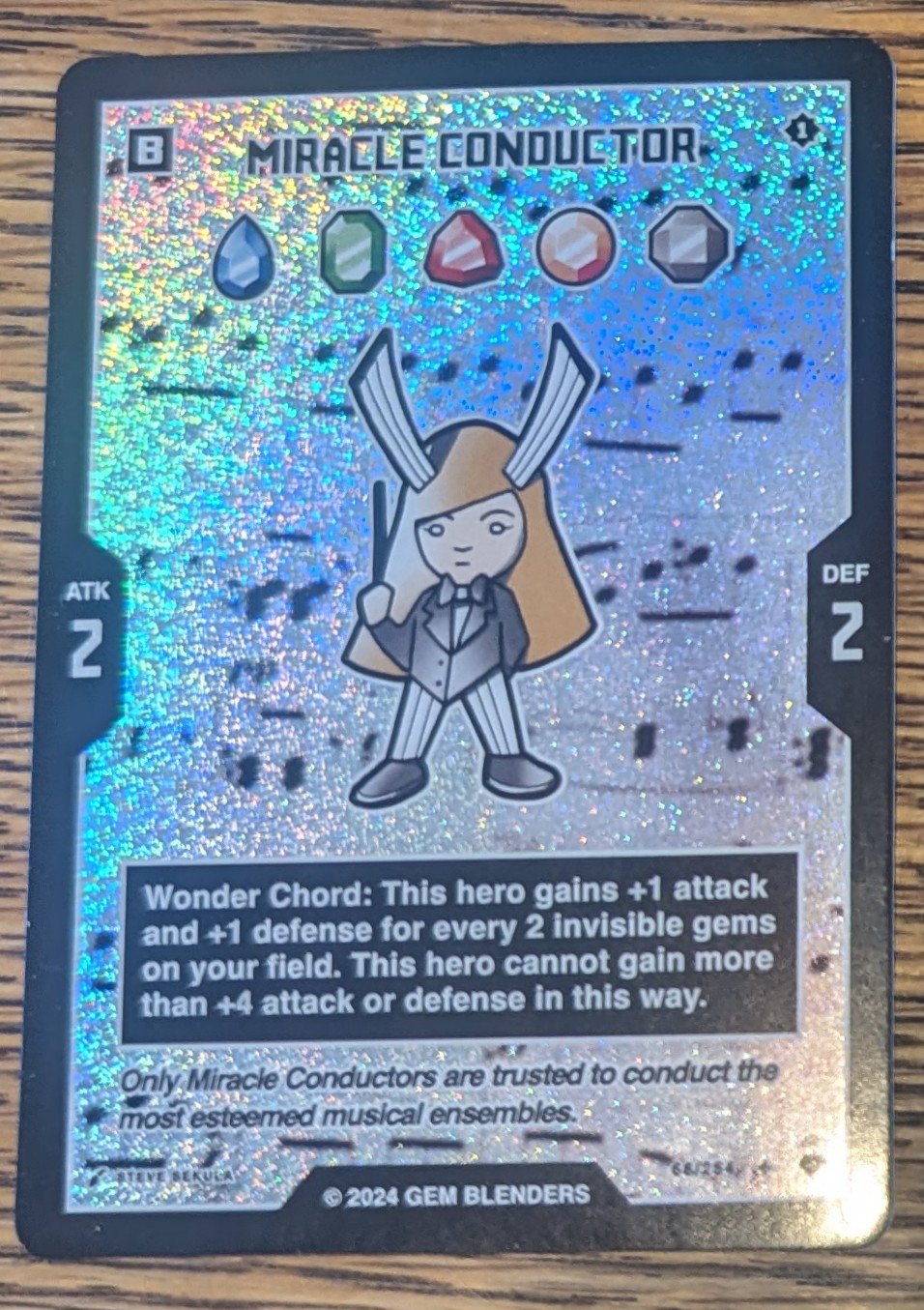
One of the cards I pulled from my booster packs.
I don't know how to get invisible gems, but I do know that a 6/6 would absolutely steamroll the starter decks.
Speaking of underwhelming, the elephant in the room for me is Gem Blenders’s art. Maybe they’re going for a sort of whimsical, Earthbound-ish retro style, but it really comes off looking like they just didn’t have a big enough art budget.
Those early hurdles aside, this is a fun game with some great potential. In the early stages of play I was worried that it would turn into an endless cycle of “I attack. Your turn.” Thankfully, the Action cards and Blend abilities make sure both players have enough tricks up their sleeves to keep things interesting.
Since this is just a first look I can’t comment on the game’s overall balance, like whether there’s one particular deck or card that dominates tournaments (although the Gem Blenders blog claims to have some insight into that). Also, since there's only one set so far, nobody knows yet how the designers will do at keeping the game alive in the future: coming up with new concepts and abilities, avoiding (or embracing) power creep, how they'll handle set rotation, and so on. What I can tell you is that the Base Set alone has, by my count, 55 Heroes and 229 other cards for players to work with. By comparison, the Pokemon TCG Base Set only had 102 cards total, so Gem Blenders has nearly tripled that.
Overall, this is a solid start, and I’m very interested to see where Gem Blenders goes from here.
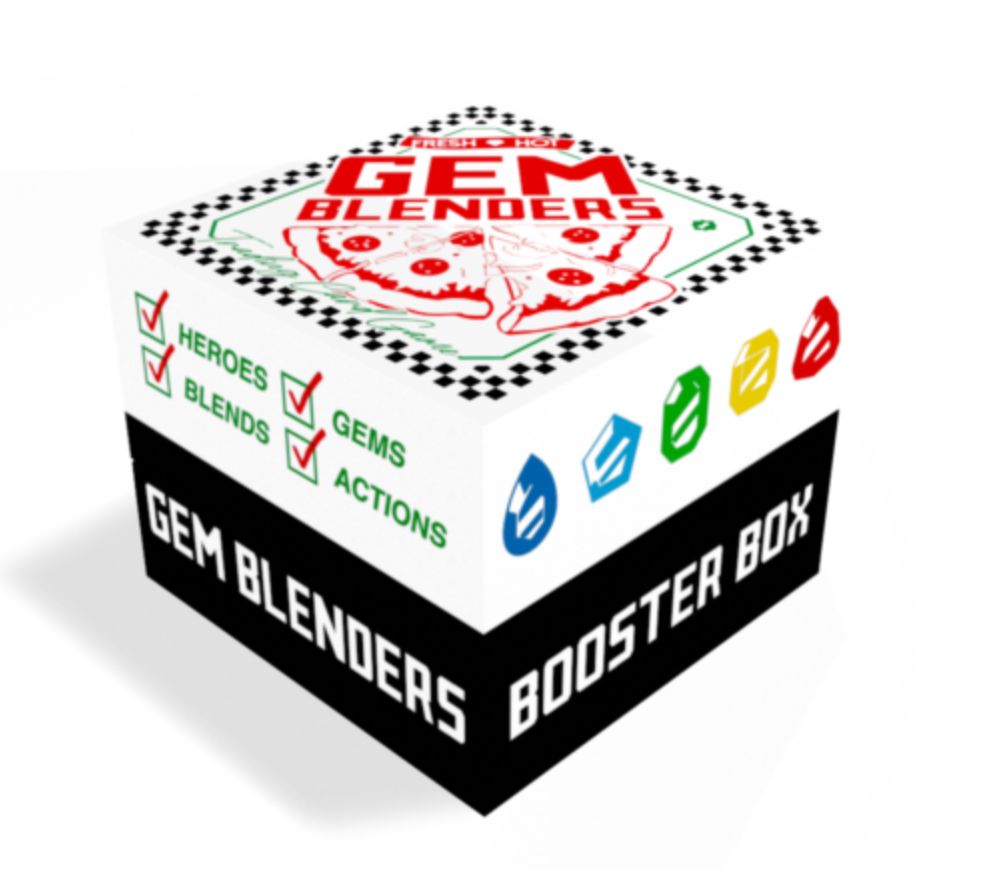
I'm also interested to know where this pizza theme comes in.
Will It Blend? That Is the Question
I hardly need to tell you that it's tough out there for new TCGs, but Gem Blenders is really putting in the work. After a successful Kickstarter campaign earlier this year, they’ve been doing the rounds at gaming conventions, maintaining an active social media presence and a Discord server, and making semi-regular blog posts on their own site to keep people talking.
I don’t know if they’ll be able to gain a foothold when they’re competing with franchises ranging from Magic: the Gathering to Dragon Ball Super and Digimon, but I wish them the best. Aside from Gem Blenders being a solid game in its own right, an indie TCG breaking into that market would be a huge win for small and mid-sized game designers.
As always, the biggest problem is money, and that’s especially true for TCGs because they need to constantly push out new content to stay alive. So, if you want to support Gem Blenders, you can check out their website or their Patreon. Or, if you’d rather see the game for yourself first, Gem Blenders will be at PAX Unplugged this year!